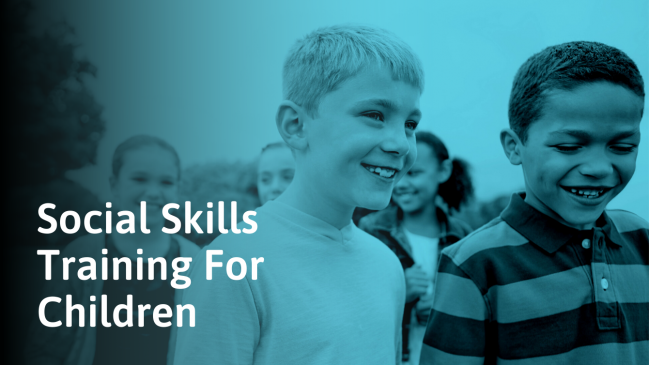To build healthy relationships with other people and enjoy good mental health, children need to understand social rules and develop a range of social skills,[1] including emotional regulation, good manners, and conflict resolution.
In this article, we’ll look at the types of social skills young children need to learn at various stages of development and how you can encourage kids to practice them.
Sections
- What social skills do children need to learn?
- Infants (up to 1 year)
- Toddlers (1-4 years)
- Primary school-aged children (around 5-6 years)
- Elementary school-aged children (around 6-12 years)
- Where do children learn social skills?
- Tips for teaching good social skills
- How a social skills support group can help
- Common questions
What social skills do children need to learn?
By the time they enter primary school, children have usually developed (or are starting to develop) the following social skills:[2][3][4]
- Reading other peoples’ emotions
- Making eye contact
- Two-way communication
- Self-advocacy
- Communicating needs appropriately
- Emotion regulation
- Listening to others
- Expressing emotions
- Self-control
- Patience
- Respecting others’ boundaries
- Conflict resolution with peers and adults
- Cooperating and sharing
- Taking turns
- Making and keeping friends
- Following directions
- Being a good sport
- Perspective-taking
- Using manners
- Coping with aggression from others
- Taking part in group activities
- Good hygiene
Simple skills, such as two-way communication, are learned at a very young age when an infant begins making deliberate eye contact with their parents and mimicking facial expressions. More complex skills, such as resolving conflict and maintaining self-control in difficult or hostile social situations, emerge years later.
You can help your child’s social-emotional development along by encouraging them to take part in age-appropriate games and activities.
How to teach social skills to infants (up to 1 year)
By the time a child reaches their first birthday, they can usually play simple games such as “Peekaboo” with their caregivers, express emotions with their face and body, repeat some gestures and sounds, and imitate facial expressions. Towards the end of this stage, they can respond to basic requests such as “Come here” and draw attention to objects by pointing to them.[3]
Try these games and activities for teaching social skills to infants:
1. Play Peekaboo
Peekaboo is very simple, but it is an effective way to help your child practice basic social interaction. By the age of four months, most infants will laugh and smile when you tickle them, pull funny faces, and play simple games.[5]
Social skills trained: Eye contact, two-way communication
2. Talk to your child before they can speak
Infants learn the meaning of words and tone of voice before they learn to talk.[6] You can encourage them to practice two-way communication and lay the foundation for learning spoken language by:
- Narrating what you are doing. For example, “Now it’s lunchtime, so we are sitting down to eat.”
- Respond to nonverbal communication with words, making eye contact as you do so. For example, if your baby pushes away their plate, say, “Have you had enough?”
- Follow your child’s lead. For example, if they babble while pointing at an object, mimic their sounds, elaborate (for example, “What’s that? It’s a dog!”) and show that you recognize the object.
Social skills trained: Listening to others, two-way communication
3. Encourage your baby to play in the mirror
Babies enjoy looking at themselves and other people in mirrors. Place your baby in front of a mirror. Make sure they can see your reflection as well as their own. Encourage them to point to different parts of their body. Show them what to do. For example, say “Nose!” as you point to your nose.
Test your baby’s self-awareness by placing a toy behind them while they look in the mirror. If they turn to grab the toy, they understand that they are looking at themselves.
Social skills trained: Two-way communication
4. Learn your baby’s communication cues
A baby’s nonverbal communication can help you work out what they want and need. This can improve two-way communication, help your child feel secure, and promote a healthy baby-caregiver relationship.[7]
For example:
- Babies may have several different cries; a particular sound that they make when they are hungry, in need of a diaper change, or when they need a nap.
- A baby’s gaze can reveal their mood. If a baby breaks eye contact and keeps looking away, they may be tired or overstimulated.
For more tips, check out the CSEFEL’s guide to understanding children’s cues.
Social skills trained: Two-way communication
5. Encourage your infant to self-soothe
A young child can’t manage their emotions alone, but caregivers can help by recognizing and responding to cues such as crying and whining. You can encourage infants to regulate their emotions by giving them a comforting object, such as a soft toy or blanket, when they are upset.[8]
Social skills trained: Emotion regulation
6. Try music and rhythm-based activities
Making music encourages your child to express their emotions and engage with you. Most babies enjoy making noises with simple “instruments,” such as rattles, wooden spoons, and shakers made from plastic bottles partly filled with dried beans or pasta. You could also go to a baby music group or singalong session.
Social skills trained: Expressing emotions
7. Try baby sign language
Babies start to speak at around 12 months of age. However, they can understand language and gestures before they can speak. This means that sign language could, at least in theory, help them communicate their needs several months before their first birthday.[9]
There’s some evidence that babies who are taught to sign might be able to communicate with their caregivers a few months earlier than those who don’t.[10] You can start teaching your baby to make simple signs (e.g., “more,” “milk”) from the age of 6 months.[9]
Check out Baby Sign Language for a guide to the basics of baby signing.
Social skills trained: Communicating needs appropriately, asking for help when needed, two-way communication
How to teach social skills to toddlers (1-4 years)
By the end of their third year, a child can usually take turns, engage in make-believe play, follow basic instructions, and play with other children.[3]
Here are some games and activities for teaching social skills to toddlers:
1. Play Roll The Ball
Sit opposite your child on the floor. Roll the ball gently towards them. When they receive it, encourage them to roll it back to you.
Social skills trained: Taking turns, two-way communication, cooperation, patience
2. Play the Name Game
This is a group activity for older toddlers that encourages listening and turn-taking. The players sit in a circle. The first child says, “My name is [name], and I like [hobby or activity],” while doing an action that represents the activity. For example, if they like playing with their dog, they can mime stroking a dog.
The rest of the group then repeats what they have just heard, e.g., “Her name is Alex, and she likes playing with her dog.”
Social skills trained: Listening to others, taking turns, patience, self-control, taking part in group activities
3. Encourage role-playing
Role-playing helps young children learn social norms and understand how they should behave in social situations. Have fun acting out various scenarios.
For example, you and your child could pretend to be:
- A customer and shopkeeper
- A diner and a server
- A doctor and a patient
- A teacher and a student
Role-playing is useful for practicing basic manners, like using “please” and “thank you.” You can also use role-play as a chance to practice advanced social interactions, such as handling disagreements. Playing a character allows a child to practice seeing a situation from another perspective.
Social skills trained: Using manners, two-way communication, eye contact, conflict resolution, respecting each others’ boundaries, coping with aggression from others, expressing emotions, reading other peoples’ emotions, taking turns, communicating needs appropriately
4. Have a staring contest
The rules are simple: the first person to blink loses. This game is a good way to encourage your toddler to make eye contact.
Social skills trained: Eye contact, being a good sport, self-control
5. Play the tickling game
Young children need to learn the concept of personal space and the importance of physical boundaries. The tickling game can help teach this lesson.
Simply tickle your child and encourage them to tickle you back. There is only one rule: When the other person says “Stop!” the game ends until the other person asks to be tickled again.
Social skills trained: Respecting others’ boundaries, listening to others, communicating needs appropriately
6. Play music-making and rhythm games
Music and rhythm activities can help children develop their social skills along with motor abilities.
- Sing nursery rhymes together to encourage language practice and development
- Supply your child with simple instruments and encourage them to make noises. Try making basic music or rhythms together
- Encourage a group of children to form a musical parade and walk in time to the beat
- Express feelings with music. Give your child an instrument, let them play with it for a while, then ask them to show you what basic emotions, such as “happy” or “angry” sound like
Social skills trained: Cooperating and sharing, expressing emotions, two-way communication, taking part in group activities, taking turns
7. Play Simon Says
This game is great for testing listening skills. All the players must only follow commands that begin with “Simon Says,” or they lose the game.
Social skills trained: Listening to others, self-control, following directions, being a good sport, taking part in group activities
8. Make and play with sock puppets
Encourage your child to put on a sock puppet play. Talk about what the characters are doing and what they might be thinking and feeling. For example, “Wow, [character] seems mad! Why is that?” You can also act out scenarios and stories with other toys such as dolls or teddy bears.
Social skills trained: Expressing emotions, two-way communication, cooperating and sharing, perspective-taking
9. Play with blocks
Building games teach children cooperation and turn-taking. Build a tower with your toddler, taking it in turns to lay down a block, or try more adventurous projects like building a bridge.
Social skills trained: Cooperating and sharing, taking turns, patience, asking for help when needed
10. Play the Animal Noises game
Everyone sits in a circle. The first child makes an animal noise. The second has to make a noise of their own, but only after repeating the other child’s noise.
Social skills trained: Listening, turn-taking, patience, taking part in group activities
11. Play board games
There are many simple board games for young children. Do not let your child win every time you play with them. They need to learn that losing at games is part of life. Try to include games that involve making decisions, such as games that require children to find matching cards or pair related items, such as shapes, together.
Social skills trained: Cooperating with others, turn-taking, self-control, being a good sport, asking for help when needed, emotion regulation, taking part in group activities
12. Do some simple mindfulness exercises
Research shows that mindfulness training can increase prosocial behavior in children.[11] Mindful has a guide to child-friendly mindfulness exercises. This resource includes exercises suitable for preschoolers.
Social skills trained: Emotion regulation, self-control, listening to others, patience
13. Play Telephone
The players sit in a circle. The first player whispers a word or phrase into the next player’s ear, who has to pass it on to the next player, and so on. When everyone has taken a turn, the first player tells everyone whether they passed the word or phrase correctly.
Social skills trained: Listening to others, self-control, patience
14. Make good hygiene fun
Try these tips to make hygiene more interesting:
- Teach your child to sing a song (of around 20 seconds in length) as they wash their hands
- Go shopping for supplies. Let your child pick out soap, a toothbrush, washcloth, and toothpaste that they are excited to use
- Make simple hygiene posters or signs for the bathroom, e.g., a red sign that says “STOP! Wash your hands!” with a basic drawing of a pair of hands
- Read fun child-friendly books about good hygiene
- Look for short videos on hygiene online
Social skills trained: Good hygiene
How to teach social skills to primary school-aged children (around 5-6 years)
By the end of their sixth year, your child’s social skills will be relatively sophisticated. By the time they start elementary school, they will probably be able to solve conflicts with others and show good self-control in social situations.[3]
Here are some games and activities for teaching social skills to primary school-aged children:
1. Play memory games
Memory games help children practice critical cognitive and social skills.
Shopping List is a classic example. The first player says, “I went shopping for…” and then gives the name of an item beginning with “A.” The next player repeats the sentence, then adds an item beginning with B. With every turn, the player adds a new item, working through the alphabet. A player is out of the game when they forget an item.
Social skills trained: Listening to others, taking turns, being a good sport
2. Play board games
As your child gets older, introduce more challenging board games. Common favorites include Connect 4, Snakes and Ladders, Guess Who, and Junior Monopoly.
Social skills trained: Taking turns, being a good sport, patience, taking part in group activities
3. Play story-telling games
Story-telling games foster imagination and language ability along with social skills.
Choose an object that is easy to see and hold, such as a block or small plush toy. Explain that the person who is holding the object gets to speak, and everyone else needs to listen.
Provide the first child with a story prompt such as “I went to the woods today and I saw…” When they’ve contributed a couple of sentences to the story, ask them to pass the object along to the next player.
Social skills trained: Listening to others, taking turns, being patient
4. Encourage your child to play team sports
Team sports help children develop self-confidence, motor skills, make friends, and practice numerous social skills. Your child will learn how to work with others to achieve a common goal but also learn how to win and lose graciously.
Social skills trained: Taking part in group activities, following directions, making and keeping friends, self-control, being a good sport, cooperating and sharing, conflict resolution, coping with aggression from others
5. Have a scavenger hunt
Scavenger hunts can be cooperative (where everyone works together to find the items as quickly as possible) or competitive (where the first individual or team to complete the list wins a prize).
You can make the hunt more or less complicated depending on the age of the players. Be ready to give clues if your child is struggling with the activity and make it clear that it’s OK to ask for help.
Social skills trained: Following directions, cooperation, being a good sport, asking for help when needed
6. Play feelings charades
Make a set of cards that depict common emotions, including happiness, fear, frustration, and anger. On each card, draw a simple face and write the name of the emotion beneath.
Shuffle the cards and let your child pick one. Challenge your child to act out the emotion on the card. When you’ve guessed the emotion, pick a card of your own and take a turn. This activity teaches the child how they appear to others (which fosters perspective-taking) and allows them to practice healthy emotional expression.
Social skills trained: Expressing emotions, reading other peoples’ emotions, making eye contact, turn-taking, perspective-taking
7. Talk about storybook characters
Reading to your child helps their cognitive, linguistic, and social development. It’s also a good way to bond with your child.[12]
As you read, talk about what is happening in the story. Ask your child questions that encourage them to empathize with the characters and think about key events.
For example:
- “Why do you think that [character] was worried about going on vacation?”
- “Do you think that [character] felt happy or sad when he got a new dog?”
- “[Character] seems puzzled! What do you think they will do next?”
It can also help to discuss characters in TV shows and movies. Talk to your child about how the characters solve problems and discuss how they behave towards each other.
If a character isn’t very socially skilled, ask your child, “Do you think [character] finds it hard to make friends?” Encourage them to think how the character could improve their friendships.
Social skills trained: Listening, perspective-taking, patience, respecting other peoples’ boundaries
8. Encourage your child to use the stoplight method
When your child feels frustrated or angry with someone, encourage them to think “Red, Yellow, Green.”[13]
Red: Think of something happy, and take deep breaths.
Yellow: Think of two possible things they could do to solve the problem, e.g., asking an adult for help, walking away from someone who is being aggressive, asking a friend to stop teasing them.
Green: Decide what to do and try it out.
To make this idea easier to understand, you could make a card or poster that lays out the steps in simple language.
Social skills trained: Communicating needs appropriately, emotion regulation, making and keeping friends, coping with aggression from others, conflict resolution, listening to others, asking for help when needed, respecting other peoples’ boundaries
9. Do some gardening
Research with school children shows that gardening with others improves their social competence.[14] Take the opportunity to emphasize hygiene. Explain why it’s important to wash your hands after working in the garden.
Social skills trained: Listening to others, cooperating and sharing, following directions, taking part in group activities, asking for help when needed, good hygiene
10. Teach the “5 senses” mindfulness exercise
Mindfulness exercises are useful tools that can help children regulate their emotions[15] and stay calm. Keep mindfulness sessions brief and fun. Try teaching your child to use the “5 senses” exercise when they feel anxious. Ask them to find something they can touch, see, hear, smell, and taste.
See Mindful’s guide to mindfulness for kids for more ideas.
Social skills trained: Emotion regulation, self-control, patience, following directions
11. Make a kindness calendar
Carrying out random acts of kindness encourages children to think of others. Suggest acts that involve reading other peoples’ emotions and anticipating when they might need help. For example, “Ask if you can help someone when they look busy” or “Leave a nice note for someone who is having a hard day.”
If you need some inspiration, take a look at the Pragmatic Parent’s random acts of kindness calendar.
Social skills trained: Using manners, perspective-taking, reading other peoples’ emotions
12. Encourage imaginative play
Imaginative or “pretend” play is a training ground for children, teaching them how to make sense of and respond to social situations. Imaginary play with others fosters communication skills and encourages sharing.
Pretend play comes naturally to most children. You can encourage it by:
- Putting together a box of dress-up clothes for role play
- Encouraging children to act out scenarios with characters, including scenarios that require good manners, such as a tea party
- Encouraging children to turn everyday things into props for play; for example, a large cardboard box could become a space ship
- Provide finger puppets or sock puppets and encourage your child to tell stories
Social skills trained: Two-way communication, cooperating and sharing, using manners
13. Make hygiene fun
Your child might be more interested in hygiene if you let them pick out their own supplies, including soap, a toothbrush, washcloth, and toothpaste that they are excited to use.
Make simple hygiene posters or signs for the bathroom, e.g., a red sign that says “STOP! Wash your hands!” with a basic drawing of a pair of hands. You can also read fun, age-appropriate books about good hygiene.
Social skills trained: Good hygiene
How to teach social skills to elementary school-aged children (around 6-12 years)
During the elementary school years, children start to place more importance on friendships.[16] They become better at teamwork and understanding other people’s perspectives.[17]
Here are some games and activities for teaching social skills to elementary school-aged children:
1. Play board games
During this developmental stage, your child will probably enjoy more complex rule-based board games. Popular choices include Monopoly (or Monopoly Junior for younger kids), Scrabble (or Scrabble Junior for younger players), Clue, Battleships, and Settlers of Catan (for older children).
Social skills trained: Taking turns, being a good sport, patience, taking part in group activities
2. Encourage your child to become a scout
Scouting gives children a chance to make friends, play games, and try new activities in a safe, structured environment. In the US, elementary school children can join various scouting organizations, including Boy Scouts USA, Girl Scouts USA, Spiral Scouts International, and Camp Fire.
Social skills trained: Taking part in group activities, making and keeping friends, being a good sport, using manners, cooperating and sharing
3. Play video games
Research shows that playing cooperative video games with other people may promote helpful, prosocial behavior in both the online and offline world.[18] Playing competitive video games may also help develop your child’s social skills; any type of game can be a useful lesson in how to win or lose gracefully.
Social skills trained: Cooperating and sharing, being a good sport
4. Encourage healthy disagreements
Elementary-aged children are capable of expressing an opinion and, as they get older, understand other points of view. Discussing issues with people who don’t always agree with them teaches children how to listen respectfully, empathize with others, and acknowledge that everyone has a different outlook on life.
Discuss topics that are appropriate for your child’s age and stage of development. Younger children can learn how to have a healthy debate by discussing a basic, noncontroversial question like, “Which is more fun: tennis or soccer?” As they get older, you can introduce weightier issues and ask questions about values and morals, such as, “Should we eat animals?” or “Should everyone have to go to school?”
Try having discussions or debates around the dinner table or when you are sharing another activity together, such as going for a walk or doing a simple craft. Encourage your child to think critically about their position by asking questions like, “Why do you think that?” If you disagree with their opinion, say so and give your reasons why.
Social skills trained: Listening to others, perspective-taking, two-way communication
5. Encourage your child to play team sports
Team sports help children develop self-confidence, motor skills, make friends, and practice numerous other social skills, including understanding personal space and “reading” other peoples’ intentions. Your child will learn how to work with others to achieve a common goal but also learn how to win and lose graciously.
Social skills trained: Taking part in group activities, following directions, making and keeping friends, self-control, being a good sport, cooperating and sharing, conflict resolution, coping with aggression from others, reading other people’s emotions, respecting others’ boundaries
6. Read to your child
Even if they are capable of enjoying a book by themselves, elementary school-aged children still benefit when their parents and caregivers read to them.[12]
Try talking to your child about the characters in a story; this can spark interesting discussions and encourage them to empathize with other people. Ask questions that encourage them to think about how the characters think and feel. For example, “Why do you think [character] felt anxious when they had a fight with their friend?”
Social skills trained: Listening to others, perspective-taking, two-way communication
7. Use a social skills training app
Social skills training apps are particularly useful for children who lack confidence or have additional needs that make it difficult for them to develop social skills. Some apps feature simple games, so your child will have fun while they learn. Try Social Quest or Hall Of Heroes.
Social skills trained: Varies by app but may include using manners, perspective-taking, conflict resolution, two-way communication
8. Teach your child to solve problems in 5 steps
Older elementary-aged children can begin to learn and use in-depth problem-solving strategies. Teach your child the following steps:[20]
1. Work out exactly what the problem is.
2. Come up with 5 solutions. Reassure your child that they don’t have to be “good” solutions; the aim is to just brainstorm potential ideas.
3. Think of the pros and cons of each solution. Ask your child, “What makes this a good idea?” then, “And what might make that a bad idea?”
4. Choose the best solution.
5. Try the solution out. Assure your child that it’s OK to try two or more solutions if the first doesn’t work and that they can ask you or someone else for help if they are still stuck.
When you face a real-life problem, try to model these steps for your child, speaking out loud if possible. Show them how to apply the strategy in day-to-day life.
Social skills trained: Self-advocacy, communicating needs appropriately
9. Introduce your child to guided meditation
Mindfulness exercises such as meditation can help your child relax and regulate their emotions.[15]
Guided meditations are often easier and more fun for children than silent practices. Check out Mindful’s guide to mindfulness for kids for free audio meditations, plus advice on introducing your child to mindfulness.
Social skills trained: Emotion regulation, self-control, patience, following directions
10. Encourage your child to join a theater group
Acting requires lots of verbal and nonverbal communication skills, teamwork, and an understanding of other people’s emotional and physical boundaries. It’s also a perfect opportunity to express emotions in a safe environment.
If your child prefers to work backstage rather than perform, they can still develop important social skills. For example, working as part of a team to paint scenery requires cooperation and clear verbal communication.
Social skills trained: Expressing emotion, eye contact, two-way communication, patience, following directions, reading other peoples’ emotions, respecting other peoples’ boundaries, taking part in group activities, taking turns, making and keeping friends
11. Do some gardening
Research with school children shows that gardening with others improves their social competence.[14] It’s also a good opportunity to emphasize hygiene. Explain why it’s important to wash your hands after working in the garden.
Social skills trained: Listening to others, cooperating and sharing, following directions, taking part in group activities, asking for help when needed, good hygiene
Where do children learn social skills?
Most children learn social skills at home, at daycare or kindergarten, and in school.
At home
A child’s first and most important role model is usually a primary parent or caregiver, and the home is the first place they learn social skills.[20] At home, they may also get to spend time with siblings. Interacting with brothers and sisters is a great opportunity to practice social skills, including sharing and cooperation.[21]
The quality of sibling relationships is linked with the relationships the children have with their parents. In general, if communication is good between a parent and their child, the child is more likely to have a healthy relationship with their sibling(s).[22]
A major advantage of social skills training at home is that caregivers can usually give their children one-on-one attention. But if a child lives in a chaotic home—for example, if their siblings are unusually disruptive—they may struggle to develop social competence.[23]
At school, kindergarten, or daycare
At school, kindergarten, or daycare, children have lots of opportunities to interact with peers and adults. They can form friendships with other students, and these relationships can help them develop social skills.[24]
Schools and daycare centers are staffed by employees with specialist training, knowledge, and qualifications in child development. They can pick up on gaps in a child’s social skills and take active steps to help them catch up. On the other hand, staff are usually responsible for multiple children, meaning that one-on-one time is limited.
Tips for teaching good social skills
Children learn and hone their interpersonal skills over many years. Patience and repetition are key to success. Try not to get frustrated with your child if they don’t pick up a new skill quickly; social skills training is a long-term project.
Here are 5 tips for teaching good social skills:
1. Be a good role model
A child’s parents and primary caregivers are their first and often most influential role models.[25] Try to set a good example. When you slip up, explain what you would do differently next time. For example, “I wasn’t very polite to that lady. I should have said ‘Sorry’ when I bumped into her.”
2. Be ready to prompt your child
Don’t expect your child to learn a skill immediately. Be prepared to guide them as they practice.
For example:
- “What do you say when someone gives you a gift?”
- “What do you do when you notice that someone needs help?”
Be careful not to overdo it; constant prompts can be overwhelming.
3. Reward good social skills
When you praise or otherwise reward good behavior, your child is more likely to repeat it in the future.[26]
When you praise your child, explain exactly what they have done right so that they know which behaviors to repeat. This is called positive reinforcement.
For example:
- “It was really kind of you to share the blocks with your brother. Well done!”
- “You were so polite to the server when we went to the restaurant. You said ‘Please’ and ‘Thank you.’ I’m proud of you!”
You could also use small tangible rewards, such as extra time to play with a favorite toy or an extra trip to the park.
4. Point out when you use social skills
Narrating your own behavior may help your child understand how people use social skills in everyday life.
For example:
- “I don’t know where the yogurt is in this store, so I’m going to ask a clerk to help me find it.”
- “I’m feeling annoyed right now because the dog chewed my shoes, so I’m going to take a few deep breaths to calm down before I do anything else.”
5. Try not to compare your child to other children
Children develop at different rates.[27] Although it’s sensible to monitor your child’s development, try not to compare their progress with their siblings or peers. If you are concerned that your child isn’t picking up social skills, or if they seem to be regressing, ask your pediatrician for advice.[27]
If there’s an underlying issue, such as an autism spectrum disorder, their doctor may recommend early intervention, such as social skills training.
How a social skills support group can help
Social skills training groups give children a chance to learn and practice social interaction with peers in the same developmental stage in a structured environment. They usually serve children who need extra help in developing their social skills and integrating into a school environment. These groups are typically led by professionals with expertise in child and teen development, such as a psychologist or a special needs educator.
Research shows that these groups can improve social skills in children with emotional and behavioral disorders (EBD), including ADHD and autism spectrum disorders.[28][29][30]
Groups are usually small, containing no more than 10 participants. Common topics for social skills groups include turn-taking, responding to others, resolving conflict, having a conversation, and taking part in group activities.
During a session, participants might be asked to:[30]
- Watch the leader model a social skill
- Role-play social scenarios that allow them to implement their skills, for example, initiating a conversation
- Receive feedback on their social skills from the group leader
Parents and caregivers are sometimes asked to attend separate sessions or workshops to learn how best to support their child.
You can find social skills support groups and programs by asking your child’s pediatrician, teacher, or school counselor for recommendations. If there aren’t any social skills support groups in your area, they may be able to connect you with a therapist or school counselor who can work closely with your child to improve their skills. You could also encourage your child’s school to set up a new group.
Common questions
Are there any free social skills worksheets for kids?
There are websites that offer free worksheets. Worksheet Place and Talking With Trees Books supply free resources, including PDFs, lesson plans, and homework, for parents and teachers who want to help children practice social skills.
Why are social skills activities important for kids?
Social skills activities teach children how to get along with other people, which in turn teaches them how to have healthy relationships. Research shows that good social skills at a young age are positively linked with good mental health, employment, and personal well-being in adulthood.[19]










